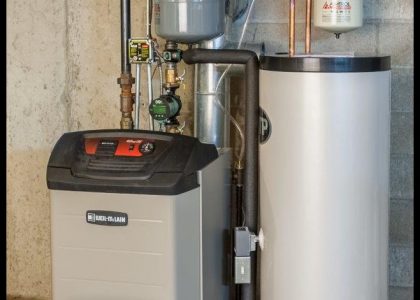Periodic discussions with Do-It-Yourselfers (DIY’s) prompt the subject of heating loops (radiation piping). In particular Steam-to-FHW Boiler Conversion inquiries inevitably ask “how do I pipe my old radiators if I want to keep them?” A good time to review distribution piping.
We must preface by stating that traditional perimeter “fin tube” radiation loops are the simplest and most efficient means of heating a structure. They lessen piping lengths, head pressure (flow resistance), minimize material & labor costs and require less circulation (distribution) energy. Beware the contemporary plumber or heating installer who claims that all of his additional “pretty piping” and controls increase performance. To the contrary! Be aware that powered air handlers, cabinets and radiant heating loops all require significant additional hydronic and electrical energy.
There are three (3) common variations of heating loops:
- The Series Loop – The most common configuration. Supply piping from one radiation element (baseboard, radiators, fan convectors, etc.) to another in a serial sequence and returning.
- The Split Loop (sometimes also called the Split Series Loop) – A larger pipe (or pair) feed to the mid-point of a series loop, supplying water to both halves and returning by individual pipes or a larger pipe, closing the loop to the boiler. A hydronically balanced circuit is necessary to minimize distribution energy.
- The Monoflo(w) Loop – A larger, closed piping loop that continually flows water. All radiation is teed off this “runway” loop to both of its ends, driven by a Monoflo Tee that pulls (moves) water through them by utilizing a “venturi effect” pipe tee.
The Series Loop is simple, but maybe too simple. How can you go wrong? Pipe from one radiation element to the next and close the loop from and to the boiler. Problem is, every fitting, foot and rise of pipe = resistance to flow. Resistance equals “head” that must be accommodated by properly sizing both piping and circulators to provide even heating. (You may want to also read our blog on “LAZY HEATING ZONES”.)
The effects may be:
- Too small a circulator and/or piping size results in a “lazy” zone – temperature (heat) in the first heating element to the last can drop significantly, providing uneven heating.
- Install too large a circulator to overcome this and you risk “hydronic noise” created by over-speeding water. Take care to not create very long piped zones as a practice.
- You inadvertently are loading your electric bill in either case. Longer circulation cycles in a “lazy” one or overpowering in the latter. Size and lay out zones properly.
The Split Loop by nature is more efficient, requiring less power to move water and lessens the temperature (heat) differential across radiation significantly. It’s also a good way to get out of trouble with a poorly performing Series Loop – as long as it’s not too poorly configured. Strategically it’s also a good choice for future splitting into individual zones. Plan ahead.
- In new construction lay out your common feed(s) and return(s) so that you anticipate future lifestyle heating options.
- In old construction, re-pipe with feeds and returns to enhance current heating conditions while again anticipating future options.
The Monoflo(w) Loop is a technique that is currently seldom used due to cost. It takes a little more pipe (and time) to configure and requires a little more circulator to drive through the required venturi tee fittings. But if you want nearly simultaneous delivery and even heating – this is it! Most often found on older baseboard or converted cast-iron radiator systems.
There is additionally a seldom used TwoPipe, Reverse Return Method as a proven way to evenly supply larger radiators or other convectors. A dedicated supply pipe (manifold) is routed and branched to each convector. A similar, separate return pipe (manifold) is likewise routed and branched to each and back to the boiler. Key is to return flow in the opposite direction to that of the supply, i.e. the first radiator supplied is the last to return. FILO = “First In, Last Out”. This reasonably balances delivery and lowers head pressure in a properly proportioned, dedicated supply and return “pipe manifold” system.
We finalize with the major current application for the Monoflo or Two-Pipe, Reverse Return System, converting Steam Radiators to FHW Heating. You MUST re-pipe every steam radiator into a separately piped supply and return, then drive them either with a Monoflo Distribution Loop or a Two-Pipe, Reverse Return System. These are the only effective ways to even out any large radiator-based zone. There’s a lot of water in those radiators! Pipe them into a Series or even a Split Loop and you will soon appreciate the term “lazy” heating. So, DIY Steam to FHW System Converters in particular take note! The result is well-balanced, even heating with less, although more forceful circulator cycling.
Know your heating loop options and do your technical homework related to pipe and circulator sizing for efficient distribution.
Author’s Note: This discussion is predicated on contemporary fixed (single or multi-select) speed circulators. The hydronic distribution “ball game” has now totally changed with the introduction of Delta-T ECM Hydronic Circulation. It is applicable to both new and existing installations, providing dramatic electrical along with some fuel consumption reductions. We are acknowledged application pioneers of this technology and have been recently awarded a U.S. Patent, Canada to follow on our ENHANCED CONVECTION, DIFFERENTIAL TEMPERATURE MANAGED, HYDRONIC HEATING APPLIANCE. All in the quest for Simple, Durable and Efficient Hydronic (FHW) Heating.
Last Edit: 01/06/2023 PDM, Sr.

